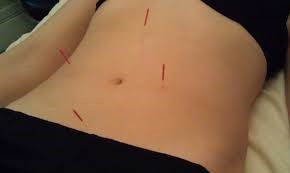Researchers find acupuncture more effective than hormone drug therapy for the treatment of endometriosis. Acupuncture relieves menstrual pain due to endometriosis, reduces the size of pelvic masses, lowers CA125 levels, and reduces the recurrence rate of endometriosis. CA125 a is biomarker for several types of cancer and benign conditions including endometriosis and menstrual disorders.

Researchers at Tongji University hospital compared acupuncture with standard drug therapy. Patients receiving acupuncture achieved a 92.0% total effective rate. Patients receiving mifepristone achieved a 52.0% total effective rate. Mifepristone, also known by its trademarked name RU-486, is a synthetic steroid that inhibits progesterone action and is used for the treatment endometriosis and also for inducing abortions. Notably, low doses of “mifepristone inhibits endometrial proliferation (Narvekar et al.).”
Acupuncture reduced pain levels more significantly than the medication. Relapse rates were less in the acupuncture group than the drug group. One year follow-up examinations determined that the recurrence rate for the group receiving drug therapy was 36%. By comparison, the group receiving acupuncture had an endometriosis recurrence rate of 20%. Pelvic mass sizes and proliferation lessened more significantly in the acupuncture treatment group than in the drug group. The findings were detected and verified with B-scan ultrasonography.
Inclusion criteria for this study included Traditional Chinese Medicinal (TCM) differential diagnostic pattern differentiation of blood stasis. In TCM, endometriosis is related to the dysfunction of the liver, spleen, and kidneys. In addition, coldness may lead to obstruction of meridians and blood stasis in the uterine region. This impedes qi and blood circulation in the uterus, leading to menstrual pain due to a lack of delivery of vital energy and nutrients to uterine tissues. Endometriosis treatment in TCM focuses on promoting blood circulation, transforming and dissolving blood stasis, and regulating the functions of the liver, spleen, and kidneys.

The treatment effective rate for all patients in the study was evaluated based on the VAS rating scale and categorized into 1 of 3 tiers:
- Significantly effective: Rating reduction of at least 50%. Significant improvement of menstrual pain.
- Effective: Rating reduction of at least 25%. Improvement of menstrual pain.
- Ineffective: Rating reduction of less than 25%. No improvement of menstrual pain.
All patients underwent Visual Analogue Scale (VAS) assessments before and after their treatments. VAS is an instrument that measures pain intensity levels experienced by patients. B-scan ultrasonography was conducted to calculate the size of pelvic masses. A CA125 test was also conducted to measure the amount of CA125 (cancer antigen 125) in the blood. CA125 is used clinically in the diagnosis and management of endometriosis.
Prior research (Chang et al.) documents that patients with endometriosis have higher levels of CA125 than women without endometriosis. Chang et al. note that the value of CA125 reflects the invasiveness of endometrial tissue beyond a normal locus. Additionally, the Tongji University researchers cite investigations demonstrating that the value of CA125 is related to the severity of dysmenorrhea (menstrual cramping and pain).
Compared with the drug group, the acupuncture treatment group displayed a significant improvement in VAS scores. Patients in the acupuncture treatment group had smaller pelvic masses caused by endometriosis and had lower levels of CA125. There is a statistically significant difference between the two groups. The researchers also conducted a follow-up survey after treatment completion. They found that the recurrence incident rate of endometriosis in the treatment group was 20%. The recurrence incident rate of endometriosis in the control treatment group was 36%.
The research demonstrates that acupuncture is a safe and effective treatment for the alleviation endometriosis. Subjective and objective data supports the conclusions of the researchers in the controlled clinical trial. Based on the data, acupuncture is found effective for the treatment of endometriosis and lowers relapse rates.
The study design was as follows. The study involved the selection of 50 patients at the acupuncture and gynecology departments at the affiliated Tongji hospital of Tongji University. All patients were diagnosed with endometriosis between January 2010 and December 2015. They were randomly divided into an acupuncture treatment group and a drug control group, with 25 patients in each group. The treatment group underwent Traditional Chinese Medicine (TCM) acupuncture therapy and the control group received mifepristone tablets.
The statistical breakdown for each randomized group was as follows. The average age in the acupuncture treatment group was 36 (±3) years. The average course of disease in the acupuncture treatment group was 2.49 (±2.11) years. The average age in the drug control group was 34 (±4) years. The average course of disease in the drug control group was 2.87 (±1.89) years. For both groups, there were no significant differences in terms of their gender, age, and course of disease prior to the beginning of the study.
The focus of this study was to scientifically verify that traditionally indicated acupoints for the treatment of endometriosis are effective. Objective examinations and subjective data confirm that the TCM treatment protocol is both safe and effective for the treatment of endometriosis. Less pain, smaller masses, and improved CA125 levels were documented. Moreover, acupuncture outperformed one type of drug therapy.
References
Shen Q, Lu J. Clinical Observation of Acupuncture-moxibustion for Endometriosis [J]. Shanghai Journal of Acupuncture and Moxibustion, 2017, 36 (6).
Narvekar, Nitish, Sharon Cameron, Hilary OD Critchley, Suiqing Lin, Linan Cheng, and David T. Baird. “Low-dose mifepristone inhibits endometrial proliferation and up-regulates androgen receptor.” The Journal of Clinical Endocrinology & Metabolism 89, no. 5 (2004): 2491-2497.
From Healthcmi.com